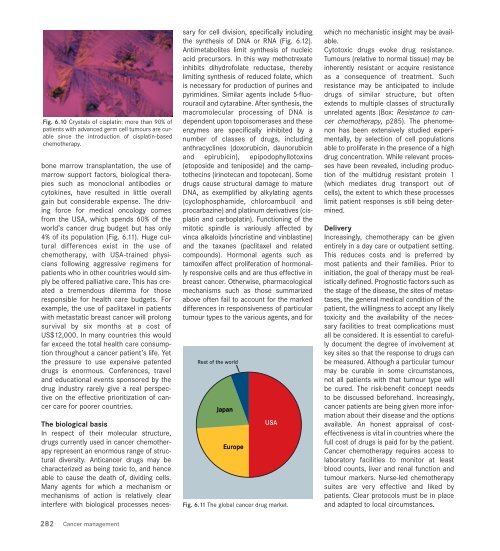world cancer report - iarc
world cancer report - iarc
world cancer report - iarc
Create successful ePaper yourself
Turn your PDF publications into a flip-book with our unique Google optimized e-Paper software.
Fig. 6.10 Crystals of cisplatin: more than 90% of<br />
patients with advanced germ cell tumours are curable<br />
since the introduction of cisplatin-based<br />
chemotherapy.<br />
bone marrow transplantation, the use of<br />
marrow support factors, biological therapies<br />
such as monoclonal antibodies or<br />
cytokines, have resulted in little overall<br />
gain but considerable expense. The driving<br />
force for medical oncology comes<br />
from the USA, which spends 60% of the<br />
<strong>world</strong>’s <strong>cancer</strong> drug budget but has only<br />
4% of its population (Fig. 6.11). Huge cultural<br />
differences exist in the use of<br />
chemotherapy, with USA-trained physicians<br />
following aggressive regimens for<br />
patients who in other countries would simply<br />
be offered palliative care. This has created<br />
a tremendous dilemma for those<br />
responsible for health care budgets. For<br />
example, the use of paclitaxel in patients<br />
with metastatic breast <strong>cancer</strong> will prolong<br />
survival by six months at a cost of<br />
US$12,000. In many countries this would<br />
far exceed the total health care consumption<br />
throughout a <strong>cancer</strong> patient’s life. Yet<br />
the pressure to use expensive patented<br />
drugs is enormous. Conferences, travel<br />
and educational events sponsored by the<br />
drug industry rarely give a real perspective<br />
on the effective prioritization of <strong>cancer</strong><br />
care for poorer countries.<br />
The biological basis<br />
In respect of their molecular structure,<br />
drugs currently used in <strong>cancer</strong> chemotherapy<br />
represent an enormous range of structural<br />
diversity. Anti<strong>cancer</strong> drugs may be<br />
characterized as being toxic to, and hence<br />
able to cause the death of, dividing cells.<br />
Many agents for which a mechanism or<br />
mechanisms of action is relatively clear<br />
interfere with biological processes neces-<br />
282 Cancer management<br />
sary for cell division, specifically including<br />
the synthesis of DNA or RNA (Fig. 6.12).<br />
Antimetabolites limit synthesis of nucleic<br />
acid precursors. In this way methotrexate<br />
inhibits dihydrofolate reductase, thereby<br />
limiting synthesis of reduced folate, which<br />
is necessary for production of purines and<br />
pyrimidines. Similar agents include 5-fluorouracil<br />
and cytarabine. After synthesis, the<br />
macromolecular processing of DNA is<br />
dependent upon topoisomerases and these<br />
enzymes are specifically inhibited by a<br />
number of classes of drugs, including<br />
anthracyclines (doxorubicin, daunorubicin<br />
and epirubicin), epipodophyllotoxins<br />
(etoposide and teniposide) and the camptothecins<br />
(irinotecan and topotecan). Some<br />
drugs cause structural damage to mature<br />
DNA, as exemplified by alkylating agents<br />
(cyclophosphamide, chloroambucil and<br />
procarbazine) and platinum derivatives (cisplatin<br />
and carboplatin). Functioning of the<br />
mitotic spindle is variously affected by<br />
vinca alkaloids (vincristine and vinblastine)<br />
and the taxanes (paclitaxel and related<br />
compounds). Hormonal agents such as<br />
tamoxifen affect proliferation of hormonally<br />
responsive cells and are thus effective in<br />
breast <strong>cancer</strong>. Otherwise, pharmacological<br />
mechanisms such as those summarized<br />
above often fail to account for the marked<br />
differences in responsiveness of particular<br />
tumour types to the various agents, and for<br />
Fig. 6.11 The global <strong>cancer</strong> drug market.<br />
which no mechanistic insight may be available.<br />
Cytotoxic drugs evoke drug resistance.<br />
Tumours (relative to normal tissue) may be<br />
inherently resistant or acquire resistance<br />
as a consequence of treatment. Such<br />
resistance may be anticipated to include<br />
drugs of similar structure, but often<br />
extends to multiple classes of structurally<br />
unrelated agents (Box: Resistance to <strong>cancer</strong><br />
chemotherapy, p285). The phenomenon<br />
has been extensively studied experimentally,<br />
by selection of cell populations<br />
able to proliferate in the presence of a high<br />
drug concentration. While relevant processes<br />
have been revealed, including production<br />
of the multidrug resistant protein 1<br />
(which mediates drug transport out of<br />
cells), the extent to which these processes<br />
limit patient responses is still being determined.<br />
Delivery<br />
Increasingly, chemotherapy can be given<br />
entirely in a day care or outpatient setting.<br />
This reduces costs and is preferred by<br />
most patients and their families. Prior to<br />
initiation, the goal of therapy must be realistically<br />
defined. Prognostic factors such as<br />
the stage of the disease, the sites of metastases,<br />
the general medical condition of the<br />
patient, the willingness to accept any likely<br />
toxicity and the availability of the necessary<br />
facilities to treat complications must<br />
all be considered. It is essential to carefully<br />
document the degree of involvement at<br />
key sites so that the response to drugs can<br />
be measured. Although a particular tumour<br />
may be curable in some circumstances,<br />
not all patients with that tumour type will<br />
be cured. The risk-benefit concept needs<br />
to be discussed beforehand. Increasingly,<br />
<strong>cancer</strong> patients are being given more information<br />
about their disease and the options<br />
available. An honest appraisal of costeffectiveness<br />
is vital in countries where the<br />
full cost of drugs is paid for by the patient.<br />
Cancer chemotherapy requires access to<br />
laboratory facilities to monitor at least<br />
blood counts, liver and renal function and<br />
tumour markers. Nurse-led chemotherapy<br />
suites are very effective and liked by<br />
patients. Clear protocols must be in place<br />
and adapted to local circumstances.

















